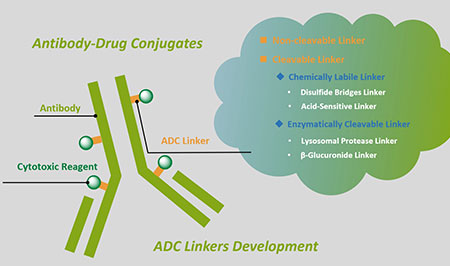1. Antibody-drug conjugates with dual payloads for combating breast tumor heterogeneity and drug resistance
Chisato M Yamazaki, Yoshihiro Otani, Wei Xiong, Ningyan Zhang, Aiko Yamaguchi, Jangsoon Lee, Yasuaki Anami, Zhiqiang An, Kyoji Tsuchikama, Naoto T Ueno Nat Commun . 2021 Jun 10;12(1):3528. doi: 10.1038/s41467-021-23793-7.
Breast tumors generally consist of a diverse population of cells with varying gene expression profiles. Breast tumor heterogeneity is a major factor contributing to drug resistance, recurrence, and metastasis after chemotherapy. Antibody-drug conjugates (ADCs) are emerging chemotherapeutic agents with striking clinical success, including T-DM1 for HER2-positive breast cancer. However, these ADCs often suffer from issues associated with intratumor heterogeneity. Here, we show that homogeneous ADCs containing two distinct payloads are a promising drug class for addressing this clinical challenge. Our conjugates show HER2-specific cell killing potency, desirable pharmacokinetic profiles, minimal inflammatory response, and marginal toxicity at therapeutic doses. Notably, a dual-drug ADC exerts greater treatment effect and survival benefit than does co-administration of two single-drug variants in xenograft mouse models representing intratumor HER2 heterogeneity and elevated drug resistance. Our findings highlight the therapeutic potential of the dual-drug ADC format for treating refractory breast cancer and perhaps other cancers.
2. The antibody drug conjugate VLS-101 targeting ROR1 is effective in CAR T-resistant mantle cell lymphoma
Yang Liu, Joseph McIntosh, Katti A Jessen, Michael Wang, Yijing Li, Vivian Changying Jiang, Brian J Lannutti, Yuxuan Che, Alexa Jordan J Hematol Oncol . 2021 Aug 28;14(1):132. doi: 10.1186/s13045-021-01143-w.
Mantle cell lymphoma (MCL) is a rare, aggressive and incurable subtype of non-Hodgkin's B-cell lymphoma. The principal barrier is frequent clinical relapse to multiple lines of therapies, including new FDA-approved biologics and cell therapy. Brexucabtagene autoleucel, the first and only FDA approved chimeric antigen receptor (CAR) T product in MCL, demonstrated unprecedented efficacy in overcoming resistance to Bruton's tyrosine kinase inhibitors. However, relapses have inevitably occurred and once relapsed these patients display a very poor clinical outcome. Currently, there is no optional therapy specifically designed for these patients. The development of tailored and more efficacious therapies is therefore critical and represents a new medical need. We found that while the receptor tyrosine kinase-like orphan receptor 1 (ROR1) is expressed across most of the MCL cells, it is significantly elevated in CAR T-relapsed MCL tumors. To see whether this aberrant ROR1 expression contributed to CAR T resistance, we targeted ROR1 using VLS-101, a monomethyl auristatin E conjugated anti-ROR1 antibody. VLS-101 showed potent anti-MCL activity in vitro in ROR1-expressing MCL cell lines and ex vivo in primary patient samples. Importantly, VLS-101 safely induced tumor regression in PDX models resistant to CAR T-cell therapy, ibrutinib and/or venetoclax. These data advocate for targeting ROR1 as a viable approach in the treatment of ROR1-positive MCL tumors, especially those with failure to prior therapies. These data also provide strong evidence for future enrollment of post-CD19 CAR T-cell relapsed MCL patients in a first in-human phase 1b VLS-101 trial. The upcoming testing in a clinical setting will provide important insights on this new therapeutic development aiming to overcome the CAR T resistance via targeting ROR1, which is a rising unmet clinical need in MCL.
3. Novel Immunotherapy Options for Extranodal NK/T-Cell Lymphoma
Yasuhiro Oki, Boyu Hu Front Oncol . 2018 Apr 30;8:139. doi: 10.3389/fonc.2018.00139.
Extranodal NK/T-cell lymphoma (ENKTCL) is a highly aggressive mature NK/T-cell neoplasm marked by NK-cell phenotypic expression of CD3ε and CD56. While the disease is reported worldwide, there is a significant geographic variation with its highest incidence in East Asian countries possibly related to the frequent early childhood exposure of Epstein-Barr virus (EBV) and specific ethnic-genetical background, which contributes to the tumorigenesis. Historically, anthracycline-based chemotherapy such as CHOP (cyclophosphamide, adriamycin, vincristine, and prednisone) was used, but resulted in poor outcomes. This is due in part to intrinsic ENKTCL resistance to anthracycline caused by high expression levels of P-glycoprotein. The recent application of combined modality therapy with concurrent or sequential radiation therapy for early stage disease, along with non-anthracycline-based chemotherapy regimens consisting of drugs independent of P-glycoprotein have significantly improved clinical outcomes. Particularly, this neoplasm shows high sensitivity to l-asparaginase as NK-cells lack asparagine synthase activity. Even still, outcomes of patients with advanced stage disease or those with relapsed/recurrent disease are dismal with overall survival of generally a few months. Thus, novel therapies are needed for this population. Clinical activity of targeted antibodies along with antibody-drug conjugates, such as daratumumab (naked anti-CD38 antibody) and brentuximab vedotin (anti-CD30 antibody conjugated with auristatin E), have been reported. Further promising data have been shown with checkpoint inhibitors as high levels of programmed death-ligand 1 expression are observed in ENKTCL due to EBV-driven overexpression of the latent membrane proteins [latent membrane protein 1 (LMP1) and LMP2] with activation of the NF-κB/MAPK pathways. Initial case series with programmed death 1 inhibitors showed an overall response rate of 100% in seven relapsed patients including five with a complete response (CR). Furthermore, cellular immunotherapy with engineered cytotoxic T lymphocytes targeted against LMP1 and LMP2 have shown encouraging results with durable CRs as either maintenance therapy after initial induction chemotherapy or in the relapsed/refractory setting. In this paper, we review this exciting field of novel immunotherapy options against ENKTCL that hopefully will change the treatment paradigm in this deadly disease.






